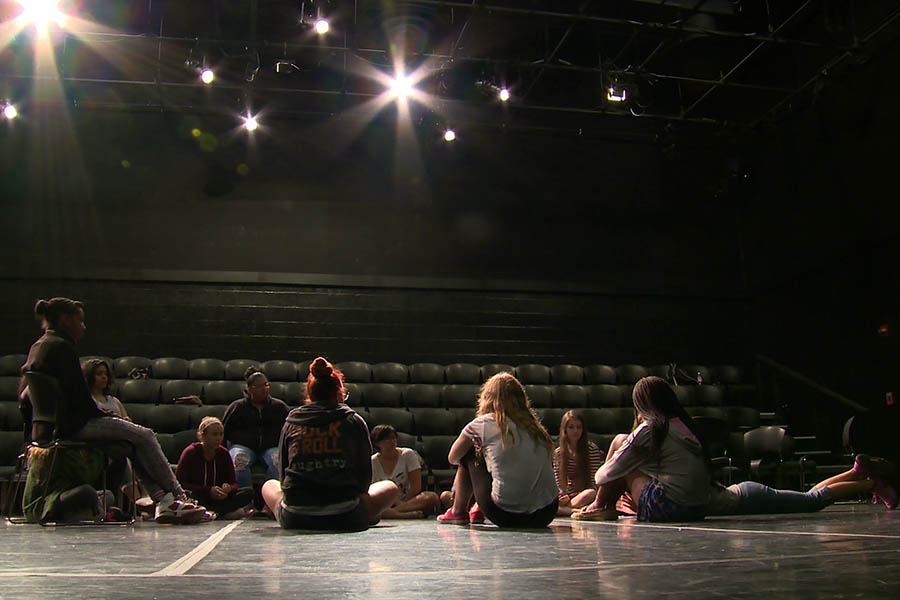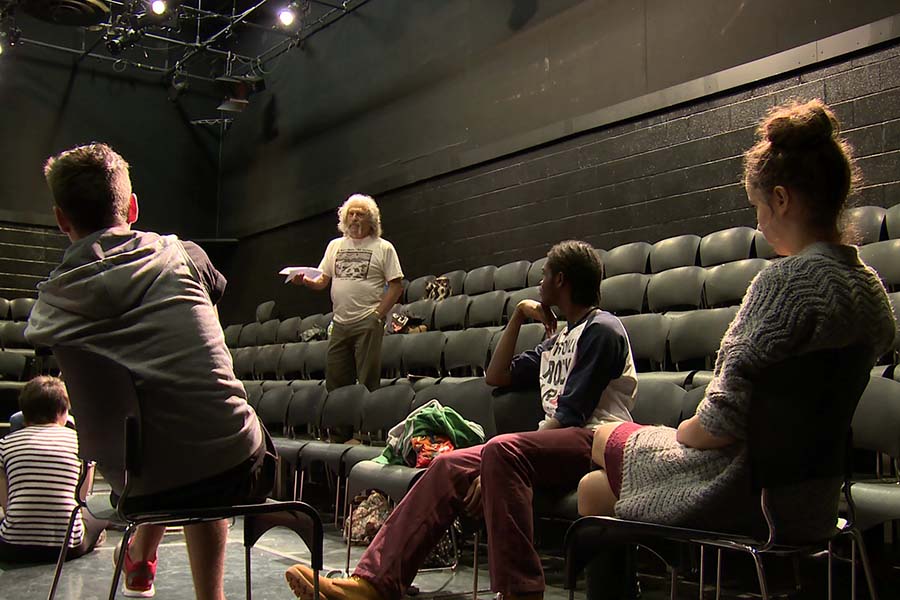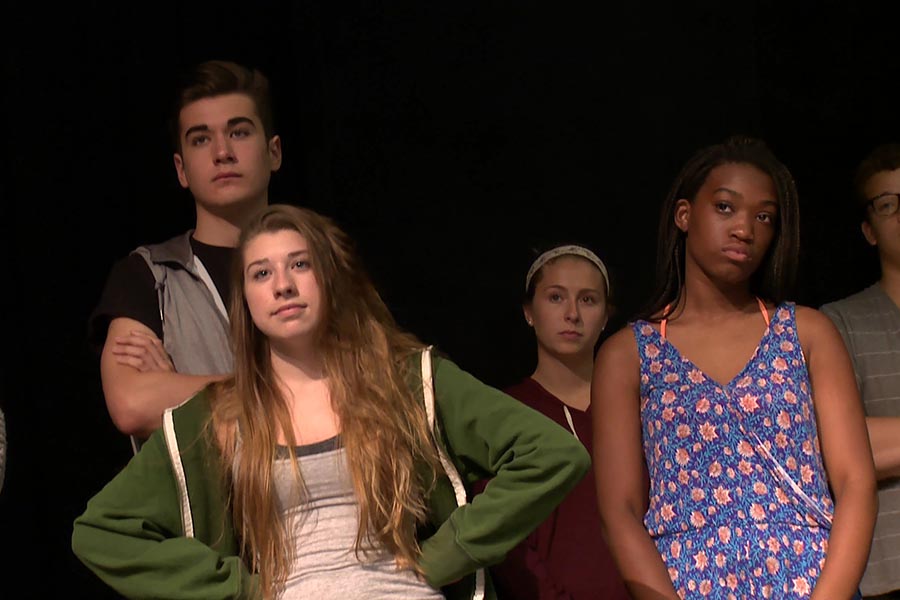As my TV crew sets up cameras and positions several portable lights, the five teen actors I’ve come to meet and interview have already begun rehearsing. I can barely hear them over the set-up activity, but they appear locked in, busy running lines and reviewing their blocking. Clearly they’ve done this before. So I just watch.
In the center of the stage, a red-haired boy in a flannel shirt sits and faces profile. Two young women—one African-American and the other Latina—peer over each of his shoulders and whisper in his ear. He’s pecking away at some kind of computer screen, and on his face there’s a wicked jack-o-lantern grin. I finally make out a few words being tossed around like “nude” and “photo.” Something creepy is definitely going down.
Nearby, at the perimeter of where our lights turn to shadows, a beefy Latino teen with a frizzy ponytail stands silently in place. He’s just waiting for his cue, but you can feel his intensity.
Finally a petite blonde in black leather enters the acting area—tentatively. Like a magnet, she’s grabbed my complete attention. Walking into the pool of light, she slowly sits to face a laptop of her own. A split-screen effect is created in the space: flannel boy on the left, the girl to the right. Studying her screen, something is seriously wrong. It’s eating at her.
Ever so carefully the girl in leather now reaches under her chair and pulls out a gun. At first she just holds it in her lap. Then very slowly she draws it up to her cheek. Her eyes seem to suddenly turn black, like a preying shark thirsty for the kill. This movement, from lap to head, she rehearses several times—and I realize I’m focused on that hand as in a movie close-up. It’s shaking, angry, willing. On the verge of tears, she remains determined.
My crew is now watching, their tasks completed. They are riveted to the action. Suddenly we can hear the girl for the very first time: “Mom. Dad. This wasn’t you.”
As her finger caresses the trigger, the barrel is again pointed to her temple. Every ounce of air is suddenly sucked out of the room. This feels real—far too real. I realize that I am holding my breath, hoping it won’t happen. The actors have me at the edge of my seat. It’s a powerful, uneasy moment.
Finally, the ponytailed boy steps into the light.

This three-minute rehearsal is my first experience with the Looking In Theatre. The young actors are focused, gutsy, and authentic. There’s no pretense or frills to the storytelling, and the action feels raw. It’s simple storytelling, no b.s.
What’s especially amazing is that except for the five teens and two folding chairs, there’s nothing else onstage. That’s right: There is no actual computer screen, no keyboard, and no laptop. There are no sets, costumes, or theatrical makeup. There is no gun. The performers have imagined it all, and through simple pantomime make us believe. When I look around, even my crew is totally sucked in, and they’re not easily impressed. They have been pulled in by the ability of the five actors to transform the room.
When we finally roll tape to capture the scene for my a PBS “All Things Connecticut” segment, with precision the actors reset. Those same emotions and actions roll out convincingly, and the girl with the “imaginary” gun doesn’t skip a beat. With a deep breath, she begins to relive that harrowing moment. I find I’m holding my breath with her all over again.
These young storytellers know exactly what they’re doing, and exactly what they want to say. Tomorrow morning at an 8:45 school assembly somewhere in New England, the odds are good that this cyber-bullying scene, with its suicidal consequences, will help save a life.
How? It’s made possible through the power of the arts to transform a room. These five teens will generate a response so strong in an audience of peers that 300 kids in a packed auditorium will tune in to their every action. Following that, a no-holds-barred dialogue will take place between the students and the actors—who will remain in character during the post-performance Q & A. It’s an extraordinary approach: a “talkback” that combines theatre, imagination, and a kind of therapeutic real-life dialogue. Best of all, no adults or teachers are allowed to interfere, and pretty much any question goes, if it’s asked earnestly and connected to the characters and the story.
According to director Jonathan Gilman, who’s been leading Looking In Theatre for nearly 30 years and will lead that post-show discussion (he’s the only adult who gets to speak), “Each time we perform we are creating a community in the room, and each performance generates a much needed conversation.”
Once that happens and kids open up, there’s a chance for action to follow through. Often, there’s a 14-, 15-, or 16-year-old who will decide to seek out a teacher or counselor to open up and get help. That girl with the leather jacket and “imaginary” gun gives the audience the courage to speak out.
During a typical Looking In assembly, a collection of scenes tackles topics like teen suicide, gay bashing, date rape, violence, alcoholism, self-harm, bullying, bulimia, transgender issues, and others. The goal is to connect with all kids, especially those who feel isolated or misunderstood.
Despite the focus on these real-life challenges surrounding teens, Gilman makes it clear that his acting company doesn’t set out to provide a magical fix. “We don’t give answers,” he insists. “I tell the actors the first day, if I had the answers I’d put them in a bottle and sell them and I’d retire, because people all want the answers. So we don’t have answers and we don’t do values. We are doing a process.”
When we complete our videotaping, I finally meet her: Zoe Lerman, the girl in the leather with the gun. She’s a senior at the Greater Hartford Academy of the Arts. Together with the four other young actors, we sit to discuss the scene and their performances. I ask why they do this and what makes Looking In so special. As talented as they all are, they could easily be doing commercials, performing in the big high school musical, or making their own films.
Instead they’d rather write and perform original material from their own lives on the chance that it will connect to kids in a live setting—teens who they don’t know, and may never see again.
I also learn it’s a rigorous investment of time and energy, including hours of soul-searching, rehearsals, writing and rewriting. It includes an intensive, five-week summer training program. All the student actors glow in their praise for the program, and this young ensemble seems hungry and eager about their mission.
They also appear prepped and ready to visit schools, and to face whatever gets thrown at them. By immersing themselves into the Looking In program, they seem to understand the remarkable potential of the arts to give them a voice: a chance to create change, and to use theatre as a tool for healing.
“It helps a lot of people become comfortable with being vulnerable,” insists Lerman. “I think it makes the touchy topics a lot easier to talk about, and so people aren’t uncomfortable with things that would normally make them uncomfortable.”
Fellow actor Angel Cooper agrees, believing that the troupe’s performances lead to meaningful action. “When I tell people about the program,” boasts Cooper, “the first thing I describe is, it’s this way that we can bring about social change. It brings about discussion where it usually doesn’t happen.”
Over the next few weeks, I get to watch Zoe, Angel, Matt, Onyx, and Danay, and numerous other Looking In actors perform at multiple school assemblies—including the scene with the gun. It’s equally stirring and effective in an auditorium filled with hundreds of students.
When the actors gather to sit and face the audience, I finally get to witness the Q & A session. Zoe and the others, remaining in character, field a series of strong questions. They make their points and handle the challenge beautifully. As I watch, the magic of Looking In really sinks in. The open conversation that breaks the fourth wall has transformed the room, giving the audience a voice and the power that comes with it. The teens in the audience are listening, reacting, and thinking. They are involved in a shared dialogue—and they don’t all agree. The energy is potent and authentic. Without cell phones, they are communicating, face to face. This is arts engagement at its finest.
Suddenly, I can’t help but think of something Angel shared during our earlier meeting about the secret of Looking In. “The point is to start discussion,” she insisted unblinkingly. “Theatre just makes it less scary. It’s just something that you can look at and say, ‘Okay, this is not real.’ But it’s real.”

Finally, the ponytailed boy steps into the light.
“Cammy?”
“Get out, Will.”
“Cammy?!”
“Get out!”
“Cammy, put down the gun. Cammy please. Put. Down. The. Gun.”
Ever so gently, he takes hold of the girl’s arm. She does not fight him. Slowly and carefully, he removes the firearm and sets it down. He looks at Cammy with understanding, then wraps his strong arms around her, engulfing her tiny frame in a giant bear hug—from which he does not let go.
He holds her in her numbness and silence.
The scene fades to black.
I completely agree with Angel. While this might be “just” theatre, it definitely feels real. Very real.
Looking In Theatre is based at the Greater Hartford Academy of the Arts, named the nation’s top arts high school in 2015. This summer Looking In has been shooting a series of webinar films in partnership with UCONN Health Psychiatric Division to train psychotherapists working with adolescents in trauma. Ed Wierzbicki is a director, producer, and educator.


